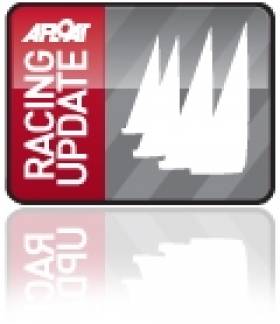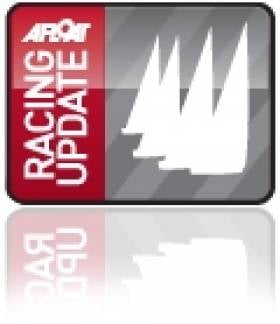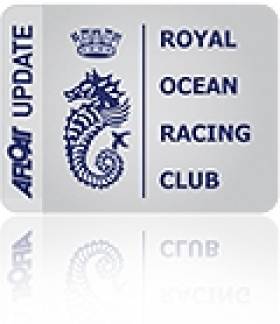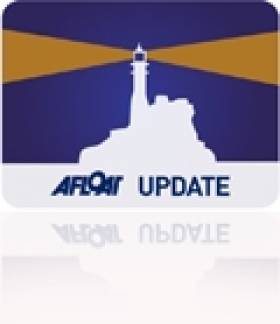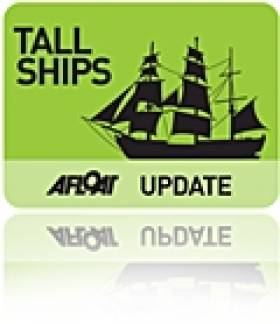Displaying items by tag: Cowes
Tiger Takes Corinthian Quarter Ton Title
The 31 boat international fleet competing at the 2011 Coutts Quarter Ton Cup were treated to three excellent races sailed in moderate northerly winds on the third and final day of the regatta. The shifty breeze, combined with strongish tides running across the racecourse for most of the day, made for challenging conditions for the tacticians and skippers alike.
The (almost) all female crew aboard Louise Morton's 'Espada' took an 11 point lead into the final day and with the tactical assistance of Stuart Childerley the girls never looked likely to relinquish the stranglehold they established on this regatta from the very first day.
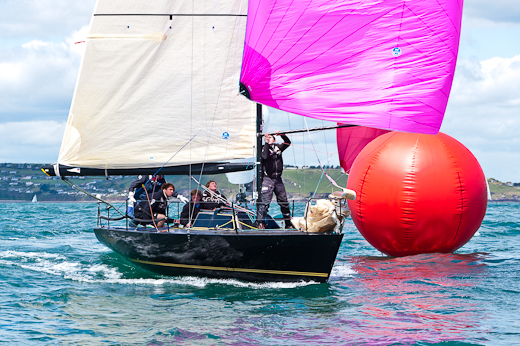
Cork's Tiger won the Corinthian division in Cowes. Photo: Bob Bateman
A third in the first race today, followed up by a first and a second in the last two races, put their comprehensive overall victory beyond any doubt. A win in the first race of the day along with second and third places in the subsequent races, elevated the winners of last year's Coutts Quarter Ton Cup, Darren Marston & Olly Ophaus on 'Cote', into second place overall. A 4,4,1 performance on the final day saw Day 1 regatta leader Rob Gray on 'Aguila', take the final overall podium place. Rickard Melander's Swedish team on 'Alice II' finished the regatta in fourth place with Eamonn Rohan's Irish crew aboard 'Anchor Challenge in fifth.
In the strictly amateur only Corinthian Division George Kenefick's Irish entry 'Tiger' confirmed overall victory with a 2,1,2 Corinthian scoreline on the final day, by a margin of 23 points. Impressively "Tiger' also finished in sixth place in the overall standings. After a putting on a good final day performance, Paul Kelsey on 'Runaway Bus' moved up to take second place in the Corinthian Division, 5 points ahead of Willy McNeil & Mike Pascall on 'Illegal Immigrant' in third.
A packed and at times slightly raucous prizegiving ceremony was held at the Royal Corinthian Yacht Club soon after racing concluded. The prize for the youngest crew competing went to 'Panic' owned by Paul & Mark Lees, with a combined age of just 142. Contrastingly, Tony Dodd's crew on 'Diamond' swept the board in the oldest crew category, totting up to 296 years between them. Diamond's George Webb also collected a beautiful wooden walking stick trophy as the regatta's oldest Bowman. 'Diamond' was also the recipient of one further tongue in cheek prize - a small tin of lubricating oil to help silence their spectacularly noisy spinnaker halliard sheave which had deafened the fleet at every leeward gate during the regatta. The Concourse D'Elegance Marineware Trophy for the smartest boat and crew, as voted for by the Race Committee, was awarded to Dmitri Borodin's Russian entry 'Bullit' - primarily for their stylish matching blue waterproofs. Having been overheard earlier in the week enthusiastically wondering if there would be a prize for the boat to finish in last place in the regatta, Richard Johnson & Sarah Lyle's on 'Hanah J' were duly awarded a specially purchased Wooden Spoon for their spirit and perseverance over the 9 race series. The trophy donated by Quarter Ton Class patron Bob Fisher and awarded to the oldest competing boat went to Paul Treliving's 'Odd Job'. Designed by Stephen Jones and built in 1973, 'Odd Job' was originally owned by Jack Knights who ironically sailed her with Bob Fisher himself in the Quarter Ton Cup that year. A new trophy donated by class stalwart Peter Morton for the first boat with her original keel went to Rickard Melander's 'Alice II' and the prize for the first production boat went to Laurent Beaurin's Farr 727 '45 South'. The Coutts Quarter Ton Trophy, awarded to the boat with the most first places in the regatta, went to 'Espada'.
Despite having owner and skipper Louise Morton sidelined due to a leg injury just prior to the regatta, the 'Espada' crew proved to be slicker in their boat handling and more astute on their tactical calls throughout the event. With a string of 5 race wins and able to discard a fourth place, it was the 'Espada' crew's sheer consistency that ultimately enabled them to dominate this regatta. Speaking immediately after the prizegiving this afternoon, replacement helmsman Colette Blair, had this to say "We are very pleased as a team to have won. I don't think it was something we expected. Coming into the regatta I think we were shooting for a top three result, so coming away with a win is a great success." Despite taking an 11 point lead into the final day Blair confessed to some last day nerves creeping in during today's 3 races. "We were still nervous going out there this morning and the first race first beat we definitely were showing signs of the jitters. We made a couple of mistakes early on, but once we had got them out of our system for the rest of the day there were no real problems." Asked about the importance of the contribution of Stuart Childerley - Espada's token male for the regatta - Blair had this to say: "Stuart's experience was something that really helped us, but also having him there really challenged us a lot too. There was no let up with him onboard. We had to be constantly on the ball, working hard all the time. We all felt that we needed to be 100 percent the whole time to keep up with what Stuart demanded of us."
Tiger Fourth and Anchor Challenge Fifth at Quarter Ton Cup
Ireland's challenge at the Coutts Quarter Ton Cup is living up to expectation with Tiger (George Kenefick) fourth and Eamon Rohan fifth in Anchor Challenge as the event enters the final phase today. Ireland's interest in the event increases with the news that three members of the crew of Anthony O'Leary's Antix from Royal Cork Yacht Club are sailing on Alice II; Nicholas O'Leary, James Hynes and Richie Watkin.

Anchor Challenge finding her form with a win in race five yesterday. Photo: Bob Bateman
Day 2 of the 2011 Cup delivered decidedly less sun but happily plenty more wind. With a solid twelve knot north-easterly blowing from early morning, the competitors were released from the marina at 09.00 and racing started bang on time at 10.30. After a couple of general recalls caused by the fleet's collective over-enthusiasm, Race 4 of the series eventually got away at the third time of asking. From the very first beat Louise Morton's 'Espada' helmed by Colette Blair, Rob Gray on 'Aguila' and 'Cote' owned by Darren Marston and Olly Ophaus, were all engaged in a nip and tuck battle at the front of the fleet. There was nothing between all three of these boats for the entire race with each of them taking the lead at various points. In the end 'Aguila' crossed the line overlapped with 'Espada' to take the line honours victory, with 'Cote' just two boatlengths back in third place on the water. On handicap however 'Espada' squeaked to victory by just a single second ahead of 'Aguila' in second place. 'Cote' had to concede third place to Ian Southworth's 'Whiskers' by 5 seconds on corrected time, pushing 'Cote' down to fourth, ahead of Paul Treliving's 'Odd Job' in fifth.
The breeze had reduced by a couple of knots by the time the fleet lined up for the start of Race 4. However the startline enthusiasm of the fleet remained undiminished, forcing another General Recall before the race could eventually get away. Rickard Melander on 'Alice II' won the committee boat end of the line and took an early lead going up the first beat. By the top mark though it was 'Espada' and 'Cote' who were fighting it out for the lead once again. These two boats continued to play a cat and mouse game with each other for the rest of the race, with 'Espada' eventually gaining control to take the win on the water by 10 seconds. This was good enough to give the 'Espada' crew their second corrected time race win of the day, ahead of 'Cote' in second and 'Whiskers' in third. Fourth was 'Alice II' with 'Panic' owned by Paul & Mark Lees taking fifth.
With conditions moderating a little more and just the hint of rain in the air, Race 5 got away under a Black Flag. With two wins under their belts, the 'Espada' crew were now on a roll and saw off sustained challenges from 'Kote', 'Alice II', Eamonn Rohan's 'Anchor Challenge', as well as George Kenefick's 'Tiger' to take another first both on the water and on corrected time. 'Tiger' corrected out into second, with 'Cote' third, 'Alice II' fourth and 'Anchor Challenge' fifth.
The various attempts to start the final race of the day involved a variety of penalty flags and resulted in 5 boats receiving Z-Flag penalties and a further 5 disqualified under the Black Flag rule. The Irish crew on 'Anchor Challenge' finally found their true form to take a line honours and corrected time win, ahead of 'Whiskers' in second and the ever present 'Espada' in third. John Welch on 'Phoenix' took fourth with Jamie McDowell & Brett Linton's New Zealand entry 'Blackfun' awarded fifth place after incurring a Z-Flag penalty.
With all of the scheduled 6 races completed and the regatta now back on track, the results show a new overall leader in the shape of Louise Morton's 'Espada'. Their impressive 1,1,1,3 scoreline for the day sees them hold a 16 point lead going into the final three races tomorrow over Ian Southworth's second placed 'Whiskers'. Yesterday's overnight leader, Rob Gray on 'Aguila', has dropped down to third tonight, just 1 point behind 'Whiskers' and 6 points ahead of George Kenefick's 'Tiger' in fourth. Rounding out the top 5 at the end of Day 2 is Eamonn Rohan's 'Anchor Challenge'.
In the newly introduced and hotly contested all ISAF certified amateur Corinthian Division, George Kenefick's 'Tiger' tops the leaderboard from Laurent Beaurin's '45 South' in second and 'Lancelot' owned by Matt Clark & Tony Thackray.
On the eve of the final day of racing the fleet assembled at the Royal Corinthian Yacht Club for the regatta gala dinner and enjoyed a fantastic after dinner speech from British singlehanded yachtswoman Sam Davies about her exploits in the Vendee Globe around the world race.
Racing at the 2011 Coutts Quarter Ton Cup concludes today with three more races scheduled.
Kenefick's Tiger Fourth at Cowes Quarter Ton Cup
With two races completed at the end of Day 1, only 7 points separate the top 6 teams at the Coutts Quarter Ton Cup . Rob Gray's 'Aquila' holds the overall lead with a total five points, tied with Louise Morton's 'Espada' in second. Rounding out the top three just one point adrift of 'Espada' is Rickard Melander's 'Alice II', who holds a 4 point advantage over Cork's George Kenefick's fourth placed 'Tiger'. Fifth at the end of Day 1 is 'Cote' owned by Darren Marston & Ollie Ophaus.
Day 1 of the Cup dawned bright and clear but with an almost total absence of the most necessary ingredient for a sailing regatta - wind. With the glassy conditions meaning that there was very little chance of racing getting away at the scheduled 10.30 start time, Principal Race Officer Robert Lamb sensibly held the fleet ashore whilst he and his race team headed off onto the Solent in search of some sort of usable pressure. Having persevered in their quest for some several hours, Lamb and his team were eventually rewarded for their patience at around 14.00, when a pleasant 10 knot south westerly breeze materialised, enabling the eager fleet to finally put to sea for what turned out to be two excellent and closely fought races.

Tiger - Lying fourth in Cowes. Photo: Bob Bateman
Despite the wide range of sizes and designs making up the 30 boat fleet, the racing could hardly have been closer both on the water and on handicap, with every startline and mark rounding fiercely contested throughout the day. In Race 1, Louise Morton's 'Espada', (helmed at this event by Colette Blair standing in for the injured Morton) turned in a line honours performance in the first race, which was good enough to also give 'Espada' a corrected time race win by just under a minute. Second in that race was last year's Quarter Ton Cup winner 'Cote' owned by Darren Marston & Ollie Ophaus, who edged Sweden's Rickard Melander on 'Alice II' into third place by just 16 seconds on corrected time. Fourth was Rob Gray's 'Aguila', ahead of Ireland's Eamonn Rohan on Anchor Challenge.
Race 2 saw a compelling three-way battle for line honours between 'Aguila', 'Alice II' and George Kenefick's Irish entry 'Tiger'. 'Aguila' eventually prevailed to take the gun and a narrow 8 second corrected time victory over 'Tiger' in second and 'Alice II' in third. 'Espada' rounded out a solid day with a fourth place ahead of Ian Southworth's 'Whiskers'.
With two races completed at the end of Day 1, only 7 points separate the top 6 teams. Rob Gray's 'Aquila' holds the overall lead with a total five points, tied with Louise Morton's 'Espada' in second. Rounding out the top three just one point adrift of 'Espada' is Rickard Melander's 'Alice II', who holds a 4 point advantage over George Kenefick's fourth placed 'Tiger'. Fifth at the end of Day 1 is 'Cote' owned by Darren Marston & Ollie Ophaus.
As the fleet returned to the dock this evening, the smiles on the faces of the sailors was a clear indication of a fun day of Quarter Tonner racing. Having travelled from Russia to compete in Cowes this week with his French Quarter Tonner 'Bullit', Dmitry Borodin said that he had thoroughly enjoyed his first experience of racing in England. "To have the chance to sail here in Cowes is a real pleasure. There are so many fantastic boats and just being here in a town with this sort of sailing heritage is fantastic. On the water I think we have much to learn but we are enjoying our first Quarter Ton Cup and we will take the message back home with us. Hopefully in years to come there will be more Russian boats coming to sail in this regatta."
Colette Blair from 'Espada' declared herself happy with her team's first day performance. "We are fortunate that Espada performs well in all conditions, but today we seemed to be going well and we are pleased with the way we sailed." Blair also commented that Espada's only non-female crew member, mainsheet trimmer Stuart Childerley, had coped well with being the only man on-board. "It's great to sail with Stuart although I think he found the general conversation onboard today rather different to what he is used to."
Anchor Challenge's Eamonn Rohan, a first timer at the Quarter Ton Cup, had also clearly enjoyed his day on the water but was quick to pay tribute to the quality of the fleet. "This is the toughest Quarter Ton racing that we have done since we bought the boat. There are so many really fast boats and competitive crews sailing here this week, it's been a bit of an eye opener. We are having fun though and looking forward to tomorrow's racing."Despite lying in last place overall Richard Johnson & Sarah Lyle on 'Hannah J' were still amongst the most enthusiastic owners checking the results in the clubhouse after racing. "We had a great day out on the water and we are really pleased not to have finished last in the second race! Can you tell this is our first time? What we are really hoping for is an overall wooden spoon prize!" commented Sarah.
Racing at the 2011 Quarter Ton Cup continues tomorrow Tuesday 12 July with three more races scheduled. The regatta concludes on Wednesday 13 July.Racing Round up: Dun Laoghaire Regatta, ISAF Youths, Optimists, Paralympic, RORC, WIORA, Quarter Ton, Kiteboarding.
In offshore news, the Transatlantic Race 2011 Nears a Finish, and RORC yachts that headed West did best in the St Malo from Cowes race. Ireland's entry in the Tall Ships race, Celtic Mist, is safely in Scotland. WIORA starts this week in Clifden, thirty boats are expected.
Two top Cork performers are in Cowes for this week's Quarter Ton Cup.
In other boating news, rower Siobhan McCrohan won bronze at the World Rowing Champs in Lucerne, Kiteboarding debuted in Dun Laoghaire. There were Medals for Irish Kayakers at Athens Special Olympics.
And finally after a Elaine 'Shooter' Alexander is set for hero's welcome this week as she becomes the first woman from Northern Ireland to circumnavigate the island of Ireland.
All on our home page this morning, thanks for your interest in Irish Sailing and Boating.
Second Irish Quarter Tonner Heads for Cowes
Following Monday's report on the Irish championship winning yacht Tiger (Neil Kenefick) sailing in the Quarter Ton Cup in Cowes next week a second Royal Cork Yacht, Eamonn Rohan's Quarter tonner 'Anchor Challenge' is also heading to the Solent. Her crew is made up of Eamonn, Nigel Young, Sam Hunt, Ian Travers and Mick Liddy. This boat won the event in 2009 so she has form. Watch this space!

Anchor Challenge is heading for Cowes. Photo: Bob Bateman. Scroll down for more.
Record-Breaking Round the Island Race Gears Up
This epic event, dubbed 'Britain's favourite yacht race' has attracted a record number of entries this year, now standing at a phenomenal 1,908 since entries closed last Saturday.
Rod Nicholls, Commodore of the Island Sailing Club, reflects the mood of everyone involved in this year's Race, saying, "We're all very excited at the prospect of welcoming a record fleet on the Royal Yacht Squadron line in Cowes early on Saturday morning. We're hoping for good sailing conditions to help get everyone away on time and safely round the Island."
The first start is at 0600 when the gun will be fired by TV personality Denise van Outen to commence a series of class starts lasting one hour 40 minutes that sees eleven different classes of boat set off on their epic one-day racing adventure.
The first finisher, taking line honours, but not necessarily winning the famous Gold Roman Bowl, is expected to cross the finish line back in Cowes at around 0930 after completing the 50 nautical mile westabout course. Lionel Lemonchois, a former winner of the Route du Rhum in 2006 and 2010, could be the first skipper celebrating. He is racing in this year's J.P. Morgan Asset Management Round the Island Race on the 50ft Trimaran Prince de Bretagne. Another of Lionel's claims to racing fame is as part of the Groupama 3 team that won the 2010 Jules Verne Trophy with Franck Cammas at the helm, racing around the globe in 48 days 7 hours 44 minutes 52 seconds.
A Race for all
After the excitement of congratulating the crew taking line honours, the team at the Island Sailing Club will be finishing boats throughout the day right up until 10pm, the time that every boat needs to have completed the Race in order to qualify for a result.
This Race is a great opportunity to watch world-renowned sailors racing against families and first timers. Although the majority of the fleet will take many hours to complete the Race, the course records stand at 3hrs 53mins 05secs for a monohull boat, set by Mike Slade on ICAP Leopard in 2008, and 3hrs 08mins 29secs for a multihull boat, set by Francis Joyon in 2001.
One of the famous names to look out for on Saturday is Ben Ainslie, triple Olympic Gold medallist, who is setting out with a steely determination to win this year and add to his gold and silverware collection. Ben is being joined on board the Ker 40 Keronimo by ace navigator Mike Broughton and Trimmer Mark Campbell-James amongst others. The ex-World Cup Rugby player Will Greenwood has also signed on as crew and will be lending a hand to this high profile team.
JP54 is the straightforward name given to a top-of-the-range fast cruiser-racer designed, and skippered in this year's Race, by Jean-Pierre Dick. He has won the 2010-2011 and the 2007-2008 Barcelona World Race as well as wearing the winner's garland at the end of the Transat Jacques Vabre in 2005.
Commenting on his entry into this 80th Anniversary Race, Jean-Pierre Dick said, "I have always really wanted to take part in this very fine event, which is certainly one of the best English yachting races. I will be discovering the Round the Island Race for the first time and I am really looking forward to taking part in this sailing festival. I got a lot of pleasure out of sailing in the Tour de Belle-Ile last May. So I am starting the cruiser racing exercise all over again, since it is particularly suited to the JP54. She is comfortable and fast. It will be simply an enjoyable moment with a crew of friends. Of course, our goal is to sail as fast as possible while enjoying the wonderful landscapes around the Isle of Wight, particularly the huge limestone cliffs. It's a magical island!"
Sir Keith Mills will be joined on board the TP52 Team Origin by double Olympic Gold medallist Iain Percy and Olympic Gold medallist Andrew 'Bart' Simpson whilst one of the world's most famous sailors, Sir Robin Knox-Johnston, will be aboard a Clipper 68 for the circumnavigation of the Isle of Wight. Sir Robin was the first person to sail single-handed and non-stop around the world in 1969.
The fairer sex is also well represented with some superb sailing talent in action. Two of the three Women's Match Racing Champions, Kate and Lucy Macgregor, are racing in Laser SB3s along with Hannah Mills who sails with Saskia Clark in the 470 class. They have all qualified for the pre-Olympics test event in Weymouth this August.
Helena Lucas, the 2.4m Paralympic sailor, is skippering a J109 as part of Team Volvo. Paul Goodison, Laser Olympic Gold medallist and 470 sailor Saskia Clark are also on a J109 but they're joined by sailing novices Denise van Outen and her friend, actor Chris Parker. Finally, steering another of the Team Volvo boats is Nick Dempsey, also on a J109 and not in his usual comfort zone! Nick is the Olympic RSX windsurf Bronze medallist and former World Champion, selected for Team GBR at the pre-Olympic test event in Weymouth.
Teenage solo sailing stars Jessica Watson and Michael Perham are teaming up to race together for the first time on a Bavaria 37 Cold Play.
Gipsy Moth IV, the historic yacht that was the home of Sir Francis Chichester when he sailed single-handedly around the world in 1966-67, is to be crewed by young sailors from UKSA.
Dame Ellen MacArthur is sailing on one of six Ellen MacArthur Cancer Trust boats competing this year with young people in recovery from cancer, leukaemia and other illnesses. The Trust is the official charity of the Race in 2011 and 2012 and we wish them all well.
Whether they complete the Race in the allotted time or not, every single entrant in this year's historic Race will be awarded a commemorative 80th Anniversary tankard.
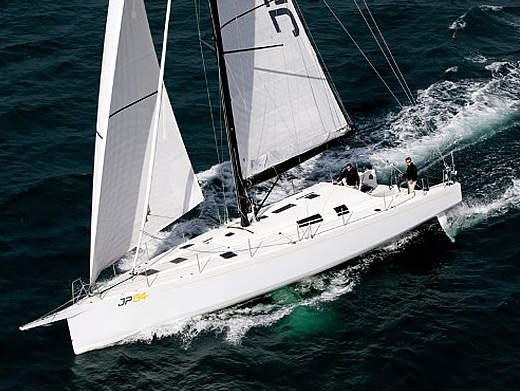
Light Solent Winds Keep O'Leary and Dowling at Bay
RORC Easter Sailing Challenge – Day 2 Light winds are keeping Irish entries in the bottom half of the respective IRC fleets at RORC's Easter challenge this weekend. After four races sailed, Royal Cork's Anthony O'Leary lies sixth from ten boats in the IRC 1 division. In IRC 2 Dun Laoghaire's Niall Dowling sailing a brand new J111 also lies sixth from ten. James Boyd reports from the Solent: With a forecast indicating no wind on the Solent, the race committee and competitors were blessed in being able to get two races in on the second day of the RORC Easter Challenge, once again held in unseasonably summer-like conditions.
While the first start was scheduled for 1000, a windless Solent saw racing postponed for three hours. Competitors were kept occupied in the Cowes Yacht Haven Events Centre with a valuable talk from Jim Saltonstall on race preparation.
Early afternoon the race committee made the brave call to get underway on a course off Hill Head despite the apparent mill pond. In fact there was wind off the water and a meaningful race was held. As women's match racer Josie Gibson, helming the new Mat 1010 in IRC 3, observed: "It was really good of them to try and do it, because the alternative was to wait for the new breeze. It wasn't totally unfair but it was just very very light. There was an awful lot of shear. At the top we were getting 5-6 knots but it was really glassy on the water."
At the end of the first race the wind began to veer into the southwest as the sea breeze prevailed and for race two, the wind picked up to an unexpected 13-14 knots with the tide running left to right across the course on the beat. From the first race, where crews were being sat down to leeward, for race two they were up on the weather rail, fully hiking.
At the end of play, in IRC1 Mike Bartholomew's King 40 Tokoloshe now shares the top spot with Rob Gray and Sam Laidlaw's Farr 50, Bob, the biggest boat in the RORC Easter Challenge fleet.
"Sam sailed the first race and we got away quite nicely. She goes like a rocketship in the light stuff," recounted Gray of his Farr 50 which is looking very smart with a new paint job and, for this season, a stiffer mast, new mainsail and an enlarged asymmetric kite. "We were sailing faster than the apparent wind. Tokoloshe is sailing very very well. In the second race today she was way to the right and was first to catch the new breeze." The two boats share the top spot due to Tokoloshe posting a fourth in today's light opener.
In IRC Two, frustrating Andrew McIrvine in his second placed First 40 La Réponse, Andrew Williams' Prima 38 Max 'Ed Out! holds the lead having won both today's races, putting them two points ahead of the RORC Commodore. Williams and his crew have made the trip up from Plymouth to compete. For this season they have changed the name of their boat from Mighty Max III after they enlarged the size of their biggest spinnaker by 35%.
"This is the first time we have raced her with the new rating and it has made a tremendous difference," said Williams. In today's ultra-light first race Williams said it was all about keeping the boat moving. "She is a 14 year old design and we have had three firsts and a fourth, which for a scratch crew with a boat with a new sail configuration we've only been out once with - we feel quite pleased with the way she is performing."
Chris and Hannah Neve's high experienced crew on the Lymington-based First 35 No Chance are slipping away in first place in IRC 3 after posting a 2-1 today. They lead Louise Morton's Mat 1010 by three points. The RORC Easter Challenge is only Mat 1010's second competitive outing. The boat is being sailed by Morton's all-female crew that normally race on the Quarter Tonner Espada, with the exception of Volvo Ocean Race winning navigator Jules Salter, taking time off from his latest campaign with Abu Dhabi Ocean Racing. "This morning was quite like Abu Dhabi," quipped helm Josie Gibson.
IRC4 is the only class to have a run-away leader in Grant Gordon's J/97 Fever, now nine points clear of Paul Blowers and Nick Daniels Impala Patriot Games, while in the J/80s Kevin Sproul made a good come back after yesterday's rig issues to win both today's races.
Despite the light wind to start with today, the conditions once again proved ideal for the on-the-water coaching provided by Jim Saltonstall, Barry Dunning and their team. The RORC Easter Challenge is a 'coaching regatta' and the competitors have been lapping up the advice during races as well as the post-race video analysis ashore.
"Today was brilliant because you could concentrate on sail shapes and not get too distracted. At least you aren't battling around in survival conditions like you normally are," commented Ben Jones, the main trimmer on Mike Greville's Erivale of today's coaching. "It is always nice to have a view from outside of the boat and there are some good people there telling you gently and sensitivity that you've got it slightly wrong. We have suffered from a bit of pressure. It is very useful."
"It is really good to have it," agreed Louise Morton of the coaching. "We enjoy going to the briefings and seeing on video how far forward we are for the starts or not. You pick up one or two things every time. Just things like trim and whether we should be sitting further forward on the boat. Jim is very incite-full."
A further two races are scheduled to start at 1000 tomorrow, the final day of racing at the RORC Easter Challenge with a forecast similar to today's.
For more information, visit the RORC web site: www.rorc.org
Fastnet Race Limit Increased
The Rolex Fastnet Race reached its entry limit 10 days after opening and over 130 boats are on the waiting list. "We were staggered at the speed with which people signed up," said RORC Commodore Andrew McIrvine. "We had to do something to satisfy the huge interest, and taking the non IRC yachts out of the total is a fair solution allowing more loyal RORC racers to get their boats into the race."
Removing the non-IRC classes will add about 50 more places to the total. "We are delighted that the Volvo's and IMOCA's want to compete in the race and that the Class 40's are coming en-masse," said RORC Chief Executive, Eddie Warden Owen. "It shows the popularity of the Rolex Fastnet that these professionally sailed boats want to join the race. However without this initiative, they would be taking valuable places away from less experienced offshore racers who view this race as a great personal challenge - their 'Everest' of sailing."
Sutton Harbour increase berthing capacity
To cater for the number of boats arriving in Plymouth, Sutton Harbour Marina has increased the amount of space by making the whole of the berthing area adjacent to West Pier and the Barbican available to the Rolex Fastnet fleet. Sutton Harbour has also become the official berth provider for the race and Chief Executive Nigel Godfroy is pleased to be associated with the race. "Sutton Harbour Marina welcomes the return of this world famous race," said Nigel. "We are very proud of the quality of facilities we have here in Sutton Harbour and being selected as the official berthing provider for the Rolex Fastnet Race. We look forward to welcoming the extra large fleet in August this year."
To accommodate the increased number of entries, space has been booked in Queen Anne's Battery, adjacent to Sutton Harbour and in Plymouth Yacht Haven in the Cattewater, where a water taxi service will be set up to connect competitors with the race office based at Sutton Harbour.
The 2011 Rolex Fastnet Race starts in Cowes, Isle of Wight on Sunday 14 August.
Sailing Opportunities on 115-year French Tall-Ship
If you are interested in this adventure, registration is open until 1 March for those registering through the Alliance Française. A special Alliance Française price (excluding insurance) costs €780 and for €660 for those under 20 years of age. To book your place email: [email protected]
In July last year, the Belem, was chartered to make a special voyage to Dublin to celebrate the 50th Anniversary of Alliance Française in the capital. Taking part in the passage from Roscoff were 17 Irish people who joined in the crew. The four-day visit also celebrated the French national day, Bastille Day (14 July) which formed part of the inaugural French Market, held on the quayside close to the Convention Centre.
The ship was launched on June 10th 1896 and built in Nantes. She was named the Belem, after the north Brazilian port where the Crouan family had founded a trading post a few generations earlier. For nearly two decades the Belem sailed the Atlantic, carrying a diverse range of cargo but mostly spices, sugar and cocoa beans. The Belem would sail upriver on the River Seine to supply the cocoa beans for a Paris-based chocolate-maker.
During her long and varied career, the barque was sold to Arthur Ernest Guinness in 1921. Under the control of the Irish brewing dynasty, the vessel was renamed Fantôme II. The Guinness family established a strong attachment to the vessel which was completely refurbished from a working cargo vessel into that of a luxurious appointed yacht capable of accommodating 40 guests. Part of the work included an extension to the deckhouse for the purposes of a floating office, so business could be conducted, wherever the vessel happened to be.
In the period between March 1923 to March 1924 the Fantome went on a round the world tour going through the Panama Canal on the way out and returning via the Suez Canal.
Since 1987 the Belem has provided sail-training opportunities and is owned and operated by the Belem Fondation, a Paris based organisation set up by the Caisses d'Epargne, BPCE Group, after they bought back the ship in 1979. The principle role of the foundation is to keep the three masted barque as part of France's National Heritage. The vessel's historical and cultural significance was recognised in 1984 when the French government listed the barque as an historic monument.
Aside the role of sail training the Belem is unique in that she continues to carry occasional commercial cargo. In recent years the vessel has carried cargoes of wine from Bordeaux to Montreal in the Canadian French speaking province of Quebec. For information about Alliance Française in Ireland logon HERE in addition to the history and work of the Belem Foundation by clicking here.
Looking for further reading on Tall Ships in Ireland? Click the links below:
Click this link to read all our Tall Ships Stories on one handy page
Previewing Ireland's Tall Ships 2011 Season
Can Ireland Get a New Tall Ship?
Ireland Lodges Appeal at Commodores' Cup
Ireland has lodged an appeal this morning against a jury decision last night that reduced Ireland's overall lead in the Commodores' Cup by ten points. The decision concerns the result of a Hong Kong boat, Christopher Opielok's Corby 36 Rockall III that was granted redress after a protest over the location of a mark. The redress affects the points of Ireland's small boat Roxy 6 who won yesterday's race. It's just one small example how the Commodores' Cup can turn says Ireland's Barry Rose in the podcast below.
The jury decision is downloadable below.
Forum debate on the Commodores' Cup HERE






























